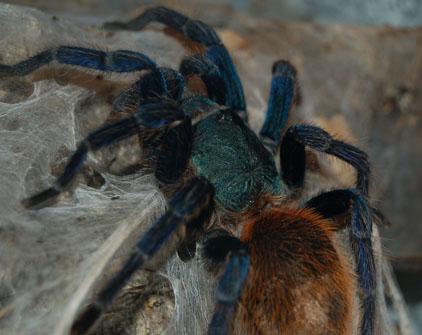The unique reason for the greenbottle blue tarantula's color has inspired researchers to develop new material that can be used to develop fade-resistant colorant or new screen technology.
November 10, 2016
Tarantulas generally strike fear into the heart of the average person, but for a group of researchers a certain type of the giant spider is providing inspiration for a new, fade-resistant textile color and next-generation screen technology.
A team of researchers at The University of Akron and the Scripps Institution of Oceanography at the University of California, San Diego, have been studying the greenbottle blue tarantula, which has a unique color that rarely occurs in this type of spider. The team has discovered why the hairs are blue, a finding that can be applied to other types of engineering scenarios, they said.
“Blue tarantulas have specialized blue hairs,” explained Bor-Kai “Bill” Hsiung, a graduate student at The University of Akron who, along with his professor Todd Blackledge, has been studying the spiders. “The hairs are blue not because of pigments, but because the internal nanostructure of the hairs only reflect blue light from the ambient environmental illumination -- it’s a structural color.”

The greenbottle blue tarantula has a unique reason for its color, a discovery made by researchers at The University of Akron and the Scripps Institution of Oceanography at the University of California, San Diego. The finding inspired the team to develop new material that can be used as a fade-resistant colorant for textiles or for television or device screen technology. (Source: Wikipedia Commons)
Further, many of these tarantulas are non-iridescent, which means the blue hue doesn’t change color depending on the direction from which someone is viewing the spider, he said. Some of the spiders achieve this non-iridescence from a flower-shaped cross section of the blue hairs, Hsiung said.
From what he learned, Hsiung developed a novel non-iridescent structural colored material in the laboratory scale that he said has the potential to scale up for mass production. “Iridescence is the main factor that limits the wide-range applications for structural colors,” he said. “Scaling-up is the bottle neck that prohibits the usage of structural colored material in everyday commodities.”
 Connected Devices & the IoT. Power is a critical resource that prevents large‐scale adoption of the many billions of IoT and wearable devices that are projected to dominate our everyday lives. Learn about IoT and wearables enablement using power electronics and energy harvesting technologies at ESC Silicon Valley, Dec. 6-8, 2016 in San Jose, Calif. Register here for the event, hosted by Design News’ parent company, UBM.
Connected Devices & the IoT. Power is a critical resource that prevents large‐scale adoption of the many billions of IoT and wearable devices that are projected to dominate our everyday lives. Learn about IoT and wearables enablement using power electronics and energy harvesting technologies at ESC Silicon Valley, Dec. 6-8, 2016 in San Jose, Calif. Register here for the event, hosted by Design News’ parent company, UBM.
The work has two key applications -- one is as a colorant that could be more environmentally friendly than synthetic pigments and dyes, as well as have a number of other improvements over typical colorants currently used. “It can be used in any situation that we need colors -- textiles, packaging, cosmetics, you name it,” Hsiung said.
The so-called “tarantula blue” colorant would be more vibrant than typical colorants because instead of absorbing light to produce color, as pigment does, its color would be structural and reflect light. It also would be more durable and retain its color without fading over time, as typical pigments do. “Structural color doesn’t fade; the color remains the same as long as the nanostructure is intact,” Hsiung said.
Structural color also is unlimited whereas pigments are not; it can be fine-tuned to any color within the human visible spectrum just by changing the size of the nanostructure, he said. Further, the nanostructure itself can be comprised of eco-friendly and/or biodegradable materials, in contrast to the pollution produced by the production of most synthetic pigments and dyes.
READ MORE ARTICLES ON BIOMIMICRY:
The structural aspect of the material also is what lends itself usefully to screen technology. Whereas most LCD/LED displays emit light, one designed on the structural principles is a reflective screen -- similar to that of a Kindle, but with colors, Hsiung said.
Hence, a “structural color” screen is more energy-efficient,” he said. “Because reflective screen utilizes ambient illumination, it can be viewed directly under sunlight -- unlike LCD/LED displays.”
Hsiung said such display technology already exists -- for example, Google’s Mirasol display. However, consumers have balked at the technology due to the poor viewing angle, or iridescent effect. “My work potentially can be used to solve the viewing-angle problem while keeping other advantages over LCD/LED displays,” he said.
Hsiung and his colleagues published a paper on their research in the journal, Advanced Optical Materials. The team will continue its research to optimize its target fabrication technology, and to demonstrate that non-iridescent structural colored materials can be made in an economically feasible way.
Elizabeth Montalbano is a freelance writer who has written about technology and culture for more than 15 years. She has lived and worked as a professional journalist in Phoenix, San Francisco, and New York City. In her free time she enjoys surfing, traveling, music, yoga, and cooking. She currently resides in a village on the southwest coast of Portugal.
About the Author(s)
You May Also Like



